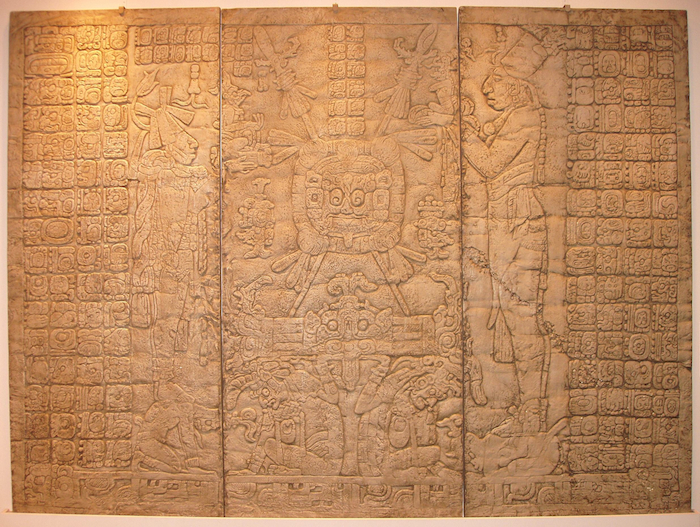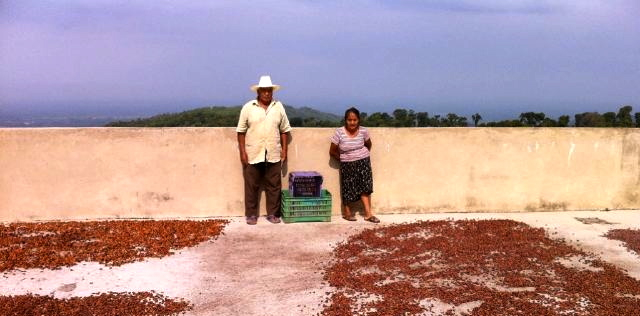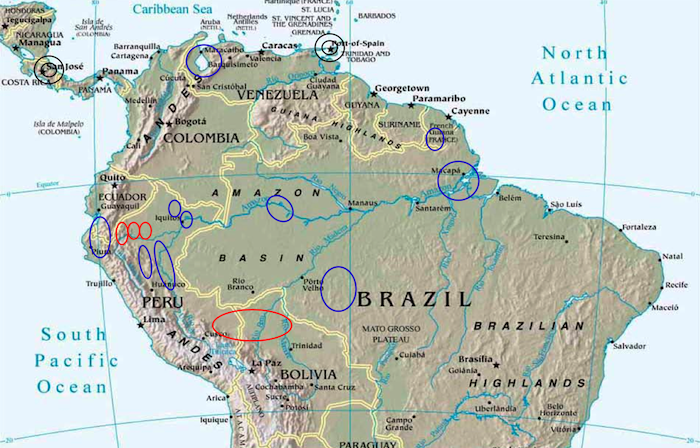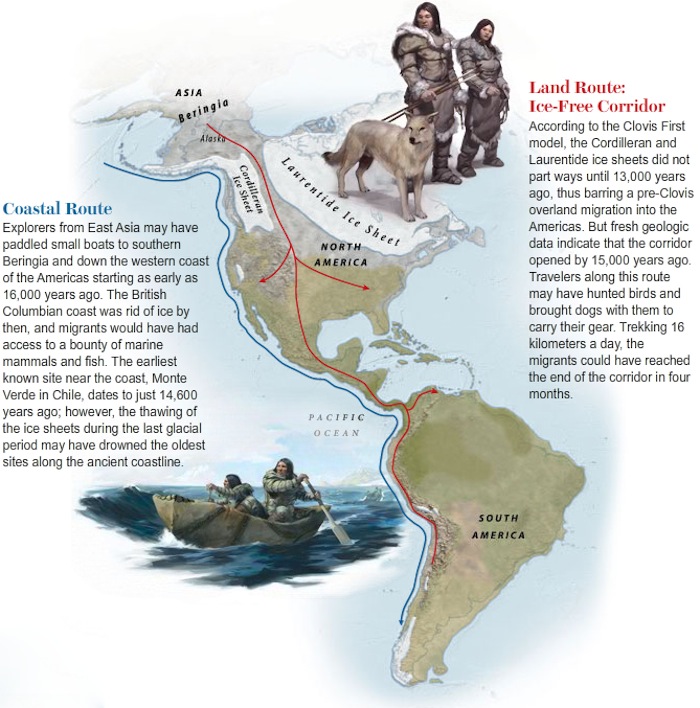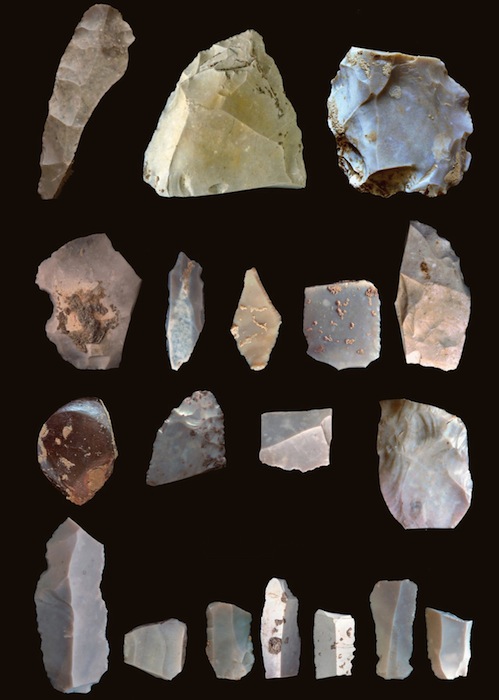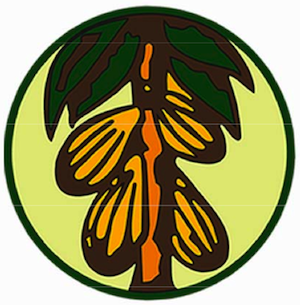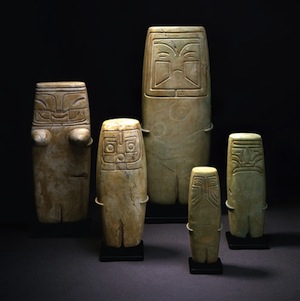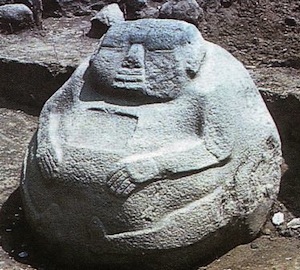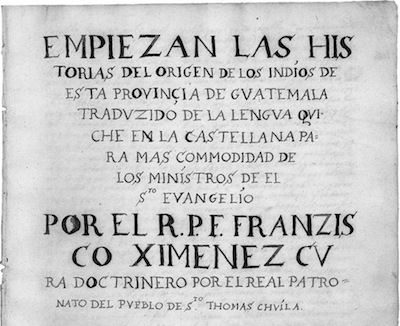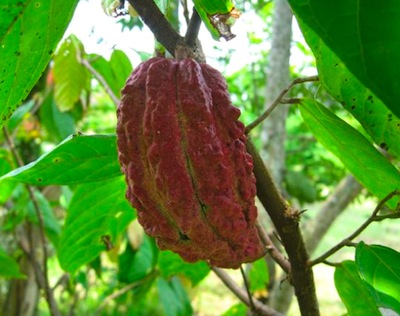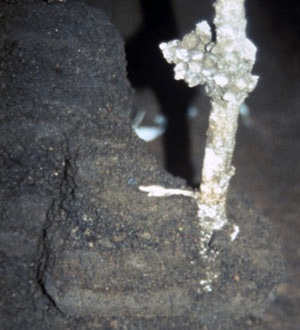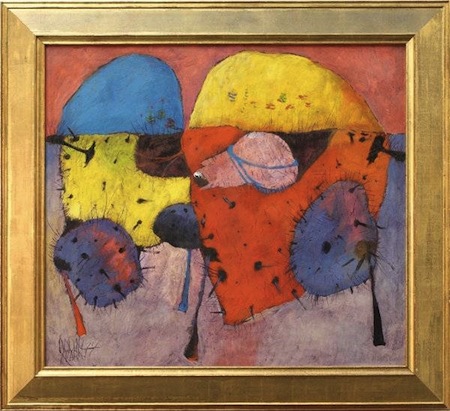3P = 1 (1 Plant <–> 1 People <–> 1 Planet)
Transcript of remarks for the Smithsonian Symposium Chocolate: From Mayan Worship to Modern Wonder held at the Museum of the American Indian on the National Mall, Washington DC
It dawned on me while walking into this great space today as I began to wonder about the relevance of holding such a symposium here & now, one that deals with chocolate primarily within a Mayan context & themed around a tasting-tour of cocoas sourced from Central America, what do North America peoples, both ancient & contemporary, have to do with any of this? This presentation meanders some, but If you follow along, its path leads back to our present circumstances… & where we go from here.
Tablet of the Sun (Palenque, Mexico)
Chocolate, humanity & earth have grown up together for millennia, forming a metaphysical trinity (such as it is), in a shared if bittersweet prosperity.
Indeed, the great poet Fernando Pessoa, also a considerable esoteric philosopher who was versed in the ethics of Spinoza, Schopenhauer’s will-to-power, & the West’s most rigorous dialectician in G.W. F. Hegel, once said, “there’s no metaphysics on Earth like chocolate!” This, from a mind whose own work explored the realms between the material, spiritual & transcendent. Quite the endorsement (& consequence) of chocolate phenomenology.
The centuries-long saga of Theobroma cacao, particularly in its New World birthplace, parallels to a large degree the story of cultural ascendancy followed by a struggle for survival of the descendants of Paleo-Americans living here, some of whom continue to cultivate it to this day.
2011: drying cacáo seeds on a rooftop in Chiapas, Mexico (photo Dr. Nat Bletter)
Social Capital, a concept coined by L.J. Hanifan & later seized upon by Post-Structuralists, defines a network of value among people which, according to Bowling Alone author Robert Putnam, is currently in decline despite social media like Facebook / Twitter, etc. If all you got are 17,842 “friends”, how well can you know any one of them?
Cacáo, & its derivative chocolate, have circulated both as a cash currency & as social currency, exchanged between the Americas &, by extension, the world. Whether as a commodity or as a gift or even a simple act of sharing, chocolate has helped to sweeten the potlatch & brighten people’s moods wherever it is found or sent. Mixing metaphors deliberately, one can say it has forever been fertilizing the social landscape & serving as a indispensable reward/treat/sacrament in our social rites.
Arguably the original cash crop & lubricant of connections, collaboration, & community in the New World, the uncanny degree to which even today chocolate’s rise & fall & resurgence mirrors the larger trends in cultural valuation can be witnessed in the microcosmic narrative of its premium craft movement.
Originating in all likelihood some 10,000-15,000 years ago among the great hardwoods in the primeval rainforest of South America, its presumed center of origin conforms to botanist Nikolai Vavilov’s theory that the origin of a species is the place where its members show the highest level of genetic diversity. As an analogy, Africans possess the most genetic variation on Earth; this suggests that the cradle of modern humans rests in an area near the coastal border of Namibia / Angola.
F.J. Pound observed enormous varieties of wild cacáo populations while exploring the Amazon in 1937-38 around the confluence of the rivers Napo, Caquetá, & Putumayo leading to the Amazon River — right in the cross-borders area of present-day Peru, Colombia, & Ecuador. Modern genetic analysis now conceives this area to be cacáo’s birthplace.
Indigenous Cacáo Hotspots (encircled)
People Power
At about the same time as cacáo took root in the Amazon, the main but by no means earliest migrations of people began settling the Americas to establish the founding civilization here.
These trailblazers crossed the Beringia Land Mass (the Bering Straits today) from Siberia into Alaska, then southward starting in earnest some 16,000 years ago.
Their ultimate transcontinental voyage spanned the hemisphere: the Arctic thru the Amazon & all the way to the Antarctic. At some point these travelers scanned the horizon &, as archeologist James M. Adovasio tells science writer Heather Pringle, “realized for the first time that smoke from all the other campsites was behind them, & ahead of them there was no smoke. And at that moment they were literally strangers in a strange land”.
Terra incognito… a wilderness untouched by humans to explore in last great habitat on the planet.
Braving the unknown, the adaptation required of these highly mobile hunters & gathers, foraging over vast distances & establishing campsites en route, ranks among mankind’s greatest feats — right up there with the moon landing.
Received wisdom holds that these original colonists were of Asian heritage.
Current interdisciplinary research encompassing geology to genetics suggests their makeup to be much richer & more diverse than conventionally thought. Though it’s PC & at times patronizing to cite “American Indians” as “natives”, everyone in the human genepool it turns out is a legitimate stakeholder to these shores.
The flow & mix of humanity in the Western Hemisphere can be traced to a wide & increasingly broad array of bloodlines:
~50,000BP (Before Present): Topper, South Carolina USA: disputed charcoal artifacts of human inhabitants
~30,000BP: appearance of Haplogroup X2 in the Americas — Haplotypes are clusters of DNA sequences on individual chromosomes that are often inherited together. These telltale genetic markers delineate major human lineages into Haplogroups. Haplogroup X2 designates an mtDNA marker for European ancestry (that is, mitochondrial DNA passed down from generation-to-generation on the matrilineal side of the family). Analysis reveals that Amerinds have a small but significant percentage of Haplogroup X in their blood, with some populations such as the Ojibwa of the Great Lakes possessing high concentrations up to 25%. In 2001 a team of researchers led by George Little published their study on Haplogroup X. They surveyed cemeteries in the Basque area around the Pyrenees Mountains of France / Spain & found X among the ancient remains of people who died 6,000-8,000 years ago. In conjunction with another study by the same research team titled Mound Builders that examined the mtDNA of ancient American populations — particularly in Northeast USA — they concluded that Haplogroup X entered the blood stream of the New World in 2 waves: by 28,000 BCE & again in 10,000 BCE (Ancient South America, p 50), thus establishing genetic links between Europe & the Americas well before Columbus. Strangely, Asians carry little to almost no X; suggesting a branch in human evolution that split off after the advent of Asia’s founding populations. Present understanding traces X back to the prehistoric southern Caucasus of Siberian Russia (specifically the Altai Mountains surrounding the Amur River valley). In other words, Amerinds have Caucasian in them (or, equally interesting, vice-versa).
~20,000BP: The Solutrean Hypothesis – advanced by Smithsonian Institution fellow Dennis Stanford, & Bruce Bradley of the University of Exeter, proposes that people from the Solutrean culture in prehistoric Europe around, interestingly enough, southern France / northern Spain Pyrenees region migrated during the Ice Age to North America, bringing with them their stone-tool technology which laid the foundation for the later Clovis points. This challenges the “Clovis First” Model that the initial peopling of America occurred in New Mexico (see below circa 11,000BP). The Solutrean case rests upon similarities between it & the Clovis that have no known counterparts in Eastern Asia, Siberia or Beringia.
~19,000-16,000BP: Meadowcroft Rockshelter, PA: pre-Clovis remains found; tools, blades, pottery, & a hearth.
~15,000 -17,000BP: Cactus Hill, southeastern Virginia near Williamsburg: stone tools indicate a possible transitional style between the Solutrean & Clovis cultures.
~15,500BP – Buttermilk Creek, TX; a trove of thousands of artifacts from blades, scrapers & tool kits unearthed
~14,600BP: Monte Verde, Chile — well-preserved community site numbering some 20-30 people who slept in hide-tents, each with a brazier lined in clay, their entire cluster situated around 2 central hearths. They dined out on seafood & dozens of edible plants, including wild potato.
~13,000BP: Peñon Woman – Mexico City; Arlington Springs (CA) Man
~12,750 – 14,400BP: Paisley Cave, Oregon — coprolite evidence containing seeds of desert parsley & other plants belonging to a Siberian &/or Asian person whose DNA includes mtDNA X 2a
~13,000BP: Clovis, New Mexico — proto Paleo-American group noted for projectile tools (long, sturdy fluted spearpoints made of bone & ivory). Once considered the first human inhabitants of the New World & the ancestors to all aboriginal Americans… a view now under siege by discovery of prior human settlements.
~10,000BP: CA-SRI-512W, Santa Rosa Island, CA — seafarers encamp at an inland canyon & leave behind bird & fish bones as well as stone knife points
~9,300BP: Kennewick, Washington (USA) — the “Kennewick Man”; 5’8” tall & probably of Polynesian origin.
As the geneological chronology shows, Asian, Polynesian & European genetic material commingled in the New World, all before Columbus’ landing in 1492CE.
The other great member of the human family – Africans – arrived via involuntary abduction, enslavement & forced transport. Beyond their sheer numbers, Africans infused these shores to the fullest measure of what it means to be American, & over generations grafted from their own bitter experience born out of indignation onto American mass culture perhaps its most vital elements—the blues at the heart of American crossroads leading to jazz in the major cities & later urban hip-hop.
Their campaign waged for universal human rights earned for themselves, & all the disenfranchised, a seat at the table.
Led by Frederick Douglas & others during the pivotal Civil War period, they made the brave decision to decline Lincoln’s offer of repatriation back to Africa. Instead, they foresaw their future in the hope of this, a promised land, laid out in the goal of the Continental Congress: freedom & justice for all, putting truth to the notion that America stands for more than a commoditized brand with a acronym logo in the stars & stripes, generically called the “USA” (the short emblem for the “meta-narrative” spouted by armies of MBAs & media mouth pieces).
It’s rather the grand idea of a nation based on principles set out in the Haudenosaunee-Iroquois Confederation, the Declaration of Independence, the U.S. Constitution, the Gettysburg Address & the Dream Speech at the Lincoln Memorial.
Power Plant
Cacáo’s own migratory pattern has also been interwoven throughout the hemisphere & the world. It starts 10,000 to 15,000 years ago in the Amazon from where it eventually made its way to Meso or Central America by air, land or sea. Air via birds; land, if Ogata / Gómez-Pompa & Taube are to be believed, thru a couple of routes (one a direct coastal trek; the other a more circuitous path); or, the preferred transit of most ancient peoples in the Americas prior to the horse & the wheel – by sea.
The Popol Vuh, a sacred text of Mesoamericans, appears to give a long count calendar date for the first sprout of maize & – by symbolic association – cacáo as 1 Manix (manix literally ‘worker with the earth’), celebrating their invention with Day-1 around 7,900BCE, probably along the Pacific Coast near current day El Salvador. This mythology coincides with the oral history of the Lenca enclave there who call themselves ‘the people of corn & chocolate’.
Research postulates a possible historical connection between Mesoamerica & the great jade-sculpting culture of the Valdivia who traveled along the Pacific coast from their Ecuador home to Peru since 2,200 BCE, & to Middle America as far north as southern Mexico since at least 1,450 BCE, perhaps trading cacáo for corn.
There in Mesoamerica, safely ensconced among people who would revere it, cacáo culture reached its zenith. Unlike their counterparts in South America where sacred plants appeared omnipresent, growing wild in virtually every river valley, hanging from trees free for the picking (Spanish Jesuit Cristobal de Acuña published New Discovery of the Amazons in 1641: “with little labor these trees may be harvested on this river without any agriculture, nature alone covers them with abundance of fruit”), inhabitants in Mesoamerica would have to cultivate cacáo. They did so with an abiding passion. Mesoamerica therefore became the center of domestication. Especially along the humid piedmont zone of the Pacific slope extending from Xoconochco Chiapas in modern Mexico, south thru the prime growing zone in Guatemala (Suchitepequez, Mazatenango, Escuintla, Guazacapán) & onward to Sonsonate (El Salvador). Cacáo stood central: its worth in commerce & cosmology rivaled only by maize.
The city-state around Chocolá (1,000BCE – 200CE) sits perhaps at the very epicenter of this cacáo zone, lying on a plateau below volcanic mountain ridges at 500-1000m altitude contiguous to this vitally important chain of cacáo groves in all of chocolate lore. That Chocolá’s environs & era largely coincides & overlaps with the distribution of ‘potbelly sculpture’, which appeared around the Late Preclassic (c. 200CE), means it comprises the heart & guts for what might affectionately be termed the geographic ‘chocolate potbelly’ of cacáo.
Early signs of high complexity at Chocolá — for instance, its hydraulic water system of irrigation from natural springs — are attributed to the intense cultivation of cacáo for a lucrative long-distance trade network. It may have indirectly borrowed from Xoconochco up the coast – an argument advanced by Yale Prof. Michael Coe in suggesting that the monumental stone-sculptors of the Izapa at Xoconocho form the connective tissue between the earlier Olmec (the so-called madre cultura or mother culture circa 2,000BCE [though some view the Olmec a sister to other cultures emerging simultaneously]) & the later Maya that loosely ties them all together. If so, this represents a key development &, plausibly, a seminal link in the rise of Classic Mayan civilization, architecture, city-states, hieroglyphic literacy, detailed ceramics, advanced math / astrology & cacáo cultivation.
Many believe that cacáo culture reached its peak then & there, for the Maya naturally selected prized cultivars for their hi-flavor, bringing forth the finest cacáo ever cultivated on Earth. It seems possibly true, insofar as Friar Francisco Ximénez, noted translator of the holy Mayan text Popul Vuh (& arguably the first known ‘chocolate critic’) inventoried the single-origin cacáos in the Americas, saying that the absolute best grew along this Pacific coast.
Over the centuries – millennia really – the Maya developed & refined chocolate craft. They planted for variety & diversity on a stunning scale – even by modern standards. Each selection based on desirable traits & described by respective fruit colors: (ix sac [white], ix kan [yellow], ix chak [red], ix morado [purple], & even ix box [black]).
(above) original title page of the Popul Vuh translation by Francisco Ximénez; (below) Mayan Criollo
Driver for the Original NAFTA?
If South America then is the center of cacáo’s origin & Mesoamerica once the center of its domestication, where does that leave North America?
Other than Chaco Canyon (New Mexico) where ceramic vessels holding traces of cacáo have been dated to 1,000CE, North America apparently sits on the sidelines, left out for the most part of pre-Columbian chocolate history.
The Mound Cultures of the Mississippi Valley, whose reach extended from the delta all the way up to Wisconsin, presumably encountered chocolate, though no evidence has surfaced yet. The Putún, a Quiche Maya group in & around coastal Vera Cruz, Yucatán Mexico, traded extensively & probably would’ve ventured north of the Rio Grande to transact with them.
Somewhat more certain are intriguing connections relating to the Pipil (literally ‘noble’) — also known as Nahuat — whose descendants today live mostly in a key ancient cacáo zone of El Salvador but whose oral history traces their lineage (perhaps mythical?) to Southwest USA.
Their migration into pueblo Mexico & farther south lasted from 600-1,000CE & maybe longer. Archeological evidence & ethno-history supports their southward diffusion. They may have been possessed by imperial visions from the north (like another latter day power) but they kept getting shoved farther & farther south by groups they encountered along their route.
The Pipil / Nahuat settled for a time around what today is called Santa Lucía Cotzumalguapa, a municipality in the Escuintla dept of Guatemala which includes the archaeological sites of El Baúl & Bilbao (Late Classic 600 – 900AD). As mentioned earlier, that region sat rich in natural resources, particularly cacáo.
An earlier portion of their storied saga supposedly took them thru the great Mayan city of Copán.
Studied by Prof. William Fowler of Vanderbilt University, & written about by one-time exiled dissident & now director of El Salvador’s national library in the novels of Manlio Argueta, their language belongs to Uto-Aztecan family, a dialect of Nahuatl called Nahuat or Pipil. That said, their mythology however is more closely akin to the Maya.
For instance, the grisly Pipil tale of Nana-huatzin seems to draw from the Mayan Hero Twins. Nana-huatzin is the youngest of 3 boys. He & a girl named Xochit Sihuat emerge from the fruit of a gourd-tree which in turn grows from the head of a woman who flew thru the night while her body slept. (The head attached itself to a deer antler; startled, the deer leapt into a canyon, thereby planting the head in the ground.) Nana-huatzin & his siblings were raised by Tantepus Lamat (“Iron-Toothed Old Woman”) until she gave her lover some food they had obtained. The kids proceeded to butcher that lover &, calling him venison, fed his body to the old woman, then killed her. They ventured out & found the world’s supply of maize was concealed within a mountain, known only to a bird covetously feeding on it. Where his siblings had earlier failed, Nana-huatzin succeeded in opening the mountain, but in doing so found himself trapped within.
This myth, along with Xipe Totec forms a wider Death Cult generally characterized by flayed skin & cannibalism in the common Maya cycle of life/death/rebirth marking agriculture fertility & bloody wars.
Additionally, Austrian physician Simeon Habel drew some of the sculptures at Bilbao in 1863; these drawings were later published by the Smithsonian. Well-preserved examples of Late Preclassic potbelly sculptures are mixed in among a style that differs from that of the Classic Maya. Speculation abounds that it arises from the Pipil.
Possible Pipil Hanidwork? Monument 4 depicts a shaman whose tongue forms a knife. Formerly located in the Monument Plaza at Bilbao & removed to the Ethnological Museum of Berlin.
At the time of the Spanish invasion, the Pipil / Nahuat were the principle cacáo lords in western El Salvador. The Izalcos, one of the 4 classes among the Pipil, amassed tremendous wealth due to their great cocoa production. A 1550 tribute assessment of the Izalco region ranks it second only to Suchitepequez (Guatemala), making it one of the jewels in the Spanish crown. So much so a colonial town – La Trinidad de Sonsonate – was built around the cacáo economy, mainly driven by a household level of production – a sign of its widespread prevalence in an area of deep historical importance for cacáo.
Taken all together the Pipil/ Nahuat made deep inroads that might have had implications for the entire intercontinental trade network inclusive of South, Central & North America.
A lasting relic of cacáo’s importance in Mesoamerica: Joya de Cerén (The Jewel of Cerén in the Valley of Zapotitlán, El Salvador), a Mayan agricultural village & Pompeii of the New World, preserved a young cacáo tree with a flower just opening up in ash from the nearby volcano Loma Caldera that erupted circa 590CE. It is the oldest known cacáo tree in existence.
Planetary Potency
Because bonds between North, South, & Central America are enduring & undeniable – encompassing migration & trade, arts & sciences – understanding their common cacáo nexus matters a great deal, insofar as it provides big picture context & above all lends insight into current affairs, furnishing a springboard to the future.
All the great streams of humanity’s bloodlines have flown together thru chocolate: from Early Americans who originally tended it (& later used it in sacred & sacrificial rites as the very symbol of blood); to European-Americans who transformed it into a global phenomenon, & African-Americans whose sharecropper hands picked cocoa along with cotton & sugar cane.
Outlandish though it may sound, cacáo is a strand that has tied them all together since time immemorial… & continues in that role today.
While wars have been fought over it (most notably the Conquistadores seizing then leveraging cacáo as part of their strategy to conquer the New World in the 16th century, hard on the heels of the Mexîcà / Aztecs led by Tlatoani (Emperor) Ahuitzotl capturing Xoconochco from the Mam-Maya circa 1495CE), the script can be flipped: chocolate by its enormous value chain spanning thousands of years over vast distances involving millions of people can educate, serving as a teaching-tool, dispensing that vital object lesson to surmount parochial identity politics in order to deal with immigration issues, border disputes, inequities & the like, for it impacts economics (roughly $100 billion annually spread over a global market) & the environment (both a cause of deforestation in its present industry as well as a potential tool for reforestation under modified agroforestry).
One alternate future holds the prospect of Theobroma cacáo returning to its roots of a premium, pure flavor powerhouse straight from the cradle of its birth — the Amazon Rainforest — endowed with ramifications for the Amazon’s preservation as a motherlode repository of the species germplasm. This re-imagines the great rainforest as a research lab for genetic safeguarding, the fruits of which can be grown & harvested elsewhere or in ecologically designed corridors &/or peripheral rings in & around the Amazon.
In this vision, Mesoamerica then once again revives those orchards & groves of yore that ennobled chocolate in the first place, restoring its former glory, elevating its stature right alongside — if not above — the other great specialties of the world to command commensurate pricing. If coffee is Mid Eastern by origin, tea of Asian provenance & wine (at least from grapes) most associated with Europe, cacáo is the Great American Botanical. An ultra people-pleaser, with the exception of maybe the Christmas Tree, no other tree on Earth has brought so much joy to the world (nor as much misery in its growing zone).
North America, which lies outside the growing zone, could serve as the chief center of consumption; a hub for a consumer-driven movement willing to underwrite the capital formation at the retail level by accepting steeper benchmark pricing for a better quality chocolate foundation that the C-spot™ describes extensively in terms of a ‘Bar-to-Bean’ dynamic.
This calls for the establishment of an Exclusive Reserve in the Americas. A ‘hands-off policy’ by Big Candy & the Agribiz Giants (ADM, Cargill, Petra, Callebaut, et. al.) when it comes to New World cultivation, to instead reap their harvests outside the Americas. A feasible goal considering the chocolate candy cartel already sources about 85% of its supply from West Africa & Sulawesi Indonesia. Such a model would leave the Western Hemisphere in the lap of neither cheap excess volume nor economies judged by scale but by quality – both ethical & standard.
In its most simplified diagram:
Branded Supply <——– Integrated Value Chain ——–> Structured Demand
The entire arrangement builds sorely needed social bridges between the consuming North & the producing South, exchanging technology transfers for genetic material, while engendering goodwill all the way around. It would help close the distance in the empathy gap separating us, enabling the realization of the shared roles that everyone will play in shaping its destiny
If successful, this model promises to serve as a template applicable wherever people cultivate cacáo across the planet, particularly impoverished West Africa & Indonesia which lead world production. With enough remuneration, it could even cut a bit into the allure of drug cartels & their attendant gang violence since cocoa could be a crop substitute for coca (or at least part of the equation).
Herbert Spencer implored that the goal of education is not knowledge but action. In 2008, the world witnessed an America filled with hope that voted for ‘change we could believe in’. Beyond a belief, it’s time to make change a reality. And more than ‘yes we can’, to work toward progress so in a couple years we can say ‘yes we are’, so that generations from now will be able to look back in the tradition of the Great Law of the Haudenosaunee-Iroquois — “in every deliberation, we must consider the impact on the 7th generation — & say ‘yes we did’.
No Es Fácil by Ixquiac Xicara, Quetzaltenango Guatemala
